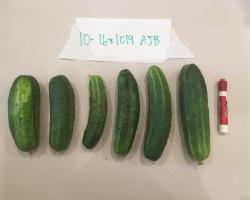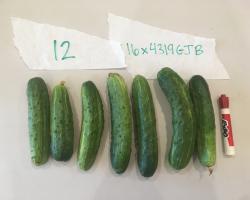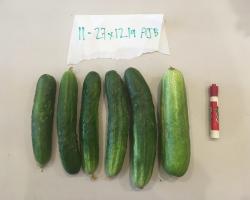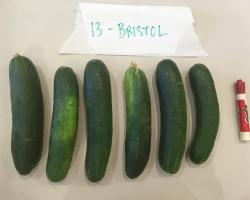The experiment was conducted at the University of Massachusetts Research and Education Farm in Deerfield, MA in a field with soil classified as a Hadley silt loam. This experiment was managed following organic standards and the field used for this study has been certified organic since 2011 by Bay State Organic Certifiers. Varieties ‘16x1019AJB’, ‘27x1219AJB’, and ‘16x4319GJB’ were soaked for approximately 12 hours in a 1% hydrogen peroxide solution to promote germination of fresh seed. Cucumber seeds were sown on 3 Jun in the greenhouse in 50-cell flats. Seedlings were fertilized with Neptune’s Harvest Hydrolized Fish Emulsion (2-4-1) at a rate of 1 fl oz/gal on 21 Jun. Field soil was amended with 50 lb N/A of Allganic (15-0-2) organic fertilizer and 90 lb K/A of potassium sulfate on 24 Jun and raised beds were formed and covered with white-on-black 1.0 mil HDPE plastic mulch. Seedlings were transplanted by hand on 28 Jun, and were immediately covered with row cover for protection against striped cucumber beetle. During the season, water was provided as needed via drip irrigation. Weeds were controlled between mulched beds by hand or by mechanical cultivation. Squash bugs were managed with Pyganic EC 5.0 II (1/2 fl oz/gal) and Azatin O (16 fl oz/100 gal). Plants were fertilized through the drip lines using 9.4 lb N/A (2.5 gal) of Nature Source Organic Plant Food (3-1-1) on 26 Jul and 30 Jul. Plots were single rows, 12-ft in length, with 8 plants at 18-in. spacing and arranged in a randomized complete block design. Rows were 20-ft apart and plots were separated within the row by 10-ft unplanted buffers. Occurrence of downy mildew (DM) and powdery mildew (PM) was assessed visually by estimating severity of disease within the plot, and also by rating severity on ten randomly selected leaves in each plot. Ratings were made on 30 Jul; 6, 13, 20 and 27 Aug; and 3, 10, and 17 Sep. ‘Ghost in the Wind’ was not rated on 10 or 17 Sep, and Marketmore 76 was not rated on 17 Sep, as these varieties did not have green tissue remaining on these dates. Disease severity data were used to calculate area under the disease progress curve (AUDPC). Marketable sized fruit (>6-in) were harvested from the plants twice weekly from 2 Aug through 27 Sep and total and marketable yields were recorded. Fruit was considered unmarketable if it was misshapen, had excessive bird or insect damage, or was symptomatic for anthracnose, caused by Colletotrichum orbiculare, or Alternaria leaf spot, caused by Alternaria cucumerina, which were also present in the trial. Average monthly temperatures (°F) were 73.9 in Jul, 69.1 in Aug, and 61.0 in Sep. Rainfall (in.) was 2.89, 2.44, and 1.00 for these months, respectively. All data were analyzed by general linear model and means were compared using Fisher’s least significant difference test (P = 0.05).
Natural inoculum of PM and DM was the only source of initial inoculum for this experiment. PM was first observed on 6 Aug in the cultivars ‘Marketmore 76’ and ‘Ghost in the Wind’. ‘Ghost in the Wind’ was dead by 3 Sep from unknown causes not related to DM or PM and therefore could not be analyzed using AUDPC. However, both diseases were observed on this variety indicating that it is susceptible to both PM and DM. All other varieties had significantly lower levels of PM than ‘Marketmore 76’. DM symptoms were first observed on 20 Aug in ‘Marketmore 76’, and then on ‘16x4319GJB’, ‘Bristol’, and ‘Ghost in the Wind’ plots on 27 Aug, and disease incidence increased rapidly thereafter. All varieties had significantly lower DM than ‘Marketmore 76’. ‘27x1219AJB’ had lowest DM AUDPC of all the varieties. Despite having the most disease, ‘Marketmore 76’ produced the highest marketable yield out of all varieties, though ‘Bristol’ and ‘16x1019AJB’ performed statistically similarly in terms of marketable yield. ‘Ghost in the Wind’ produced a significantly lower marketable yield than all other varieties—plots did not produce significant harvests until 13 Aug, four weeks after all other varieties, and all ‘Ghost in the Wind’ plots were dead by 3 Sep.
| Table 1. harvest data and dm and pm Audpc | ||||||||
|---|---|---|---|---|---|---|---|---|
| total weight (lbs)x | Marketable weight (lbs)x | DM AUDPCy | PM AUDPCy | |||||
| Marketmore 76 | 151.5 | cd | 109.9 | d | 1356 | c | 997.5 | b |
| 16x1019AJB | 119.4 | bc | 88.59 | bcd | 459.4 | ab | 214.4 | a |
| 27x1219AJB | 109.2 | b | 67.09 | b | 183.8 | a | 43.75 | a |
| 16x4319GJB | 101.8 | b | 75.35 | bc | 358.8 | ab | 236.3 | a |
| Bristol | 162.4 | d | 100.9 | cd | 581.9 | b | 406.9 | a |
| Ghost in the Wind | 34.64 | a | 22.71 | a | --z | --z | ||
| p-value | <0.0001 | 0.0003 | 0.0003 | 0.0028 | ||||
|
Data were analyzed using PROC GLM and means were separated using Fisher’s LSD. Numbers within each column followed by the same letter are not significantly different from each other. xTotal and marketable yields from each plot were recorded twice weekly and are here summed across the whole season. yArea under the disease progress curve was calculated using the formula : ∑n i=1[(Ri+1 + Ri)/2] [ti+1 – ti], where R = disease severity rating (% of leaf surface affected) at the ith observation, ti = time (days) since the previous rating at the ith observation, and n = total number of observations). Values were calculated based on the average percent disease severity across the plot. zGhost in the Wind was dead by September 3 rating, from unknown causes not relating to downy or powdery mildew and therefore could not be analyzed using AUDPC. Both diseases were observed on this variety, indicating it was susceptible to both. |
||||||||
| table 2. whole-plot downy mildew severity (%) | ||||
|---|---|---|---|---|
| 27-Aug | 10-sep | |||
| Marketmore 76 | 12.5 | b | 95 | c |
| 16x1019AJB | 0 | a | 48.75 | b |
| 27x1219AJB | 0 | a | 21.25 | a |
| 16x4319GJB | 1.25 | a | 36.25 | ab |
| Bristol | 1.25 | a | 35 | ab |
| Ghost in the Wind | 1.25 | a | 7.5 | a |
| p-value | 0.0457 | 0.0005 | ||
| Data were analyzed using PROC GLM and means were separated using Fisher’s LSD. Numbers within each column followed by the same letter are not significantly different from each other. | ||||
This research was supported by Common Wealth Seed Growers and the New England Vegetable & Berry Growers’ Association





